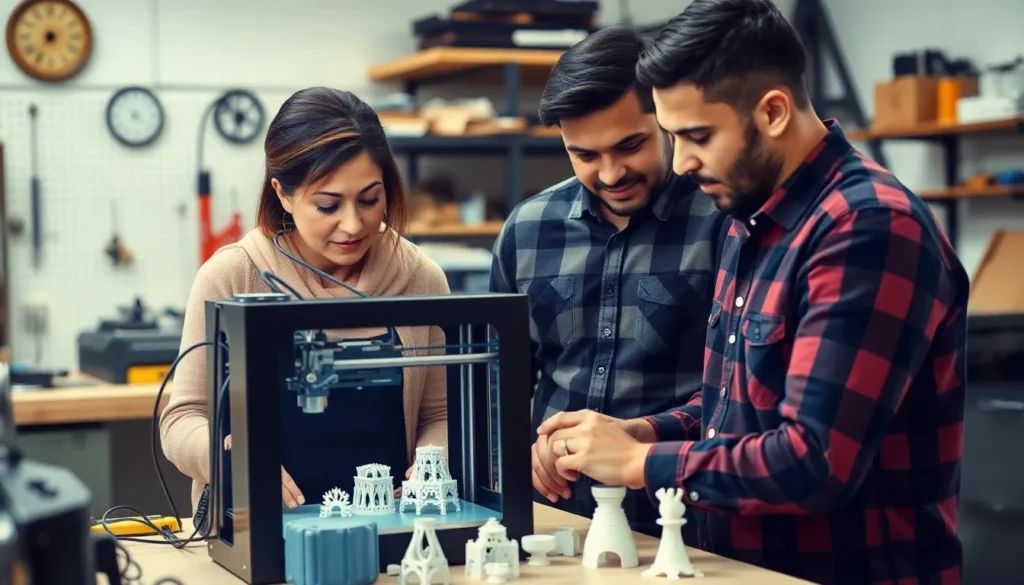Imagine a world where your wildest ideas materialize before your eyes, where yesterday’s sci-fi dreams transform into today’s reality. Welcome to the future of 3D printing, where creativity knows no bounds and the only limit is your imagination—or perhaps your printer’s filament. From custom sneakers to entire homes, this technology is revolutionizing how we create and consume.
Table of Contents
ToggleOverview of 3D Printing Technology
3D printing technology, also known as additive manufacturing, creates three-dimensional objects layer by layer. This process starts with a digital model, usually designed using Computer-Aided Design (CAD) software. Devices like fused deposition modeling (FDM) printers utilize thermoplastic filaments, while stereolithography (SLA) printers employ resin materials.
Significant advancements have made 3D printing accessible across various industries, including aerospace, automotive, and healthcare. Manufacturing companies leverage these innovations to produce prototypes quickly. Customization becomes easy; unique designs can be easily modified for specific needs.
Materials play a pivotal role in 3D printing. Options range from plastic and metal to concrete and biocompatible materials. This versatility allows for the production of diverse items, such as medical implants and functional prototypes. Sustainability also gains attention with eco-friendly materials emerging in the sector.
High precision characterizes advanced 3D printing systems. Technologies like Selective Laser Sintering (SLS) produce intricate designs without the need for support structures. Digital fabrication processes expand possibilities, enhancing efficiency and reducing waste significantly.
Ongoing research and development continue shaping the future landscape of 3D printing. Innovations promise faster production rates and improved material properties. As the technology evolves, expect to see an increase in applications, including construction, fashion, and virtual reality.
Industries are integrating 3D printing with other technologies, such as the Internet of Things (IoT) and artificial intelligence (AI). This integration fosters smarter manufacturing solutions and enhances product quality. The endless potential of 3D printing continuously inspires creativity and transforms traditional production methods.
Current Trends in 3D Printing

Current trends in 3D printing showcase how the technology is evolving rapidly and transforming multiple sectors.
Advancements in Materials
Innovative materials redefine what can be produced through 3D printing. Plastics lead the way, with types such as PLA and ABS being popular for prototypes and consumer products. Metals also gain traction, with titanium and stainless steel used in aerospace and medical fields. Biocompatible materials emerge, enabling the creation of customizable implants and prosthetics. Concrete 3D printing expands possibilities in construction, allowing whole structures to be printed on-site. Eco-friendly options, including recycled materials, address sustainability concerns while maintaining performance. Specialty materials like carbon fiber-infused plastics enhance strength and durability to meet specific needs. Each advancement expands the scope of applications in various industries.
Innovations in Techniques
Cutting-edge techniques enhance the efficiency and capabilities of 3D printing. Selective Laser Sintering (SLS) stands out by producing complex geometries without support structures. Fused Deposition Modeling (FDM) continues to be popular due to its simplicity and cost-effectiveness. Direct Energy Deposition (DED) allows for real-time material addition in repairs and manufacturing, showcasing versatility. Advances in multi-material printing enable the creation of items combining properties from different substances, pushing design boundaries. Incorporating technologies like AI and machine learning optimizes print processes, improving quality and speed. Continuous advancements reshape the landscape of how products are conceived and manufactured.
Predictions for the 3D Printing Future
The future of 3D printing looks promising with advancements expected in various sectors.
Impact on Manufacturing
Manufacturing will undergo significant transformation through 3D printing. Industries will leverage custom production capabilities, allowing for rapid prototyping and reduced lead times. Cost savings will occur as traditional methods shift to on-demand printing, minimizing waste. Increased design freedom will lead to intricate components that were previously unattainable. Companies will likely adopt digital inventory, which reduces storage costs and enables quick adjustments to designs. Enhanced materials will improve product durability and performance, pushing manufacturers toward more sustainable practices.
Influence on Healthcare
In healthcare, 3D printing is set to innovate patient care significantly. Custom implants tailored to individual anatomies will become common, improving surgical outcomes. Bioprinting may enable the development of tissues and organs, addressing critical shortages in transplants. Medical professionals will use 3D-printed models for pre-operative planning, allowing for enhanced surgical precision. Additionally, educational tools, such as anatomical models, will become more accessible within medical training. The potential for personalized medication delivery systems could reshape treatment plans, focusing on individualized patient needs.
Challenges Facing 3D Printing
Adoption of 3D printing faces several notable challenges that impact its widespread use. High costs associated with advanced equipment and materials present significant barriers for small businesses. Many companies struggle to justify investments in expensive 3D printers, especially in competitive markets.
Quality control remains a critical issue. Inconsistencies in printed products can result from variations in materials or printer settings. Achieving the desired precision and accuracy often requires sophisticated machinery and expertise, which can be difficult for newcomers.
Regulatory hurdles also complicate the landscape. The lack of standardized regulations in additive manufacturing creates uncertainty for businesses. Compliance with safety and manufacturing standards is essential, particularly in industries like healthcare and aerospace.
Intellectual property concerns add to the complications. 3D printing makes replicating designs easier, posing threats to original creators. Protecting innovative designs in a digital format remains a convoluted challenge, demanding new legal frameworks.
Limited material options hinder the full potential of 3D printing. While advancements continue, many specialized materials still lack availability in the market. This limitation affects the range of products that can be effectively produced.
Sustainability might also become a critical factor. While the industry explores eco-friendly materials, the environmental impact of certain plastics and metals raises questions. Balancing production efficiency with sustainability goals requires continual innovation and commitment.
User expertise plays a pivotal role, too. Mastering 3D design and printing processes necessitates specialized knowledge, often overwhelming for casual users. Ongoing education and training programs are essential for fostering a skilled workforce.
Collaboration across industries could help address these challenges. Engaging stakeholders and innovators will drive better solutions, enhancing the overall landscape of 3D printing technology.
The future of 3D printing holds immense promise as it continues to reshape industries and redefine creative possibilities. With advancements in technology and materials, the potential for innovation is boundless. As businesses embrace custom production and sustainability, they can expect to see improved efficiency and reduced waste.
However, addressing challenges like high costs and regulatory hurdles will be crucial for broader adoption. Collaboration across sectors may pave the way for solutions that enhance quality and accessibility. As 3D printing evolves, it will undoubtedly play a vital role in transforming how products are designed and manufactured, making it an exciting area to watch in the coming years.










